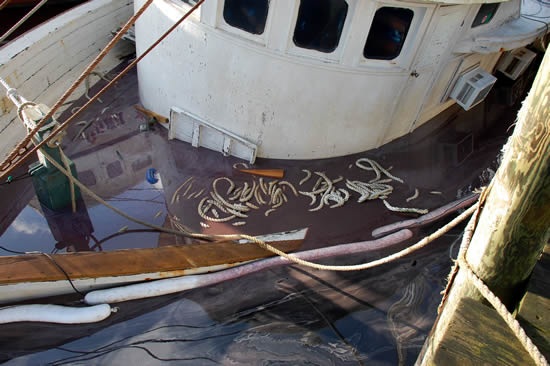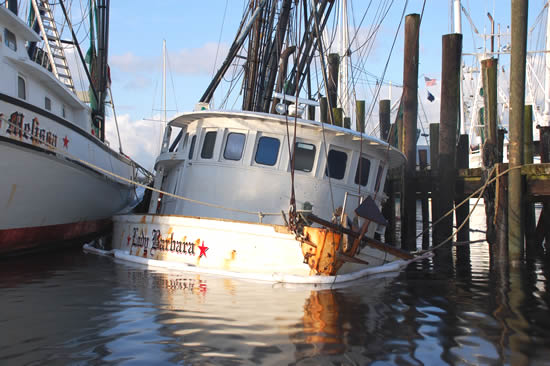It's Saturday April 20, 2024
January 29, 2013
Two weeks after she sank, and a week after she was set afloat again at the Garland Fulcher Seafood docks, the Lady Barbara remains tied up there. This has sparked questions in Oriental about why the trawler’s owner hasn’t moved the boat to Jarrett Bay boatyard yet, as the docks’ owner says he has been urging him to do.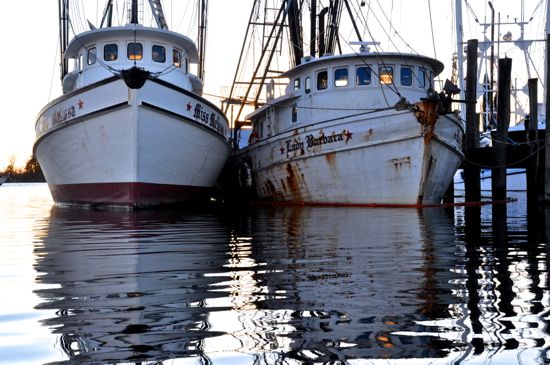 Lady Barbara, righted and floating once again, here photographed alongside her sister ship, Miss Melissa last week. The dock owner, Sherrill Styron says he had expected the boats’ owner, Ralph Taylor, to have removed the trawlers by now.
Lady Barbara, righted and floating once again, here photographed alongside her sister ship, Miss Melissa last week. The dock owner, Sherrill Styron says he had expected the boats’ owner, Ralph Taylor, to have removed the trawlers by now.Another question that’s cropped up in recent days is what penalty the Lady Barbara’s owner, Ralph Taylor, might face for allowing pollutants to spill from his vessel when it sank. The answer is: $3,000 or less.
Lt. Commander Weaver chief of the Coast Guard’s Incident Management Division in Wilmington says $3,000 is the highest fine the Coast Guard can levy for spills such as the Lady Barbara’s.
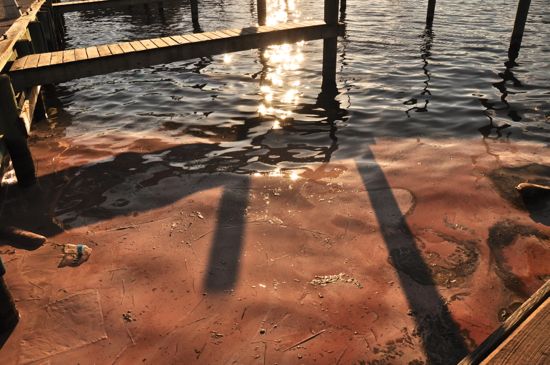 A substance looking like pink mousse collected on the north side of the harbor after the Lady Barbara sank.
A substance looking like pink mousse collected on the north side of the harbor after the Lady Barbara sank.There is also the possibility that the boat’s owner could avoid any fine at all and receive only a Letter of Warning for allowing the pollutants to dirty the harbor, as well as nearby Smith and Greens Creek.
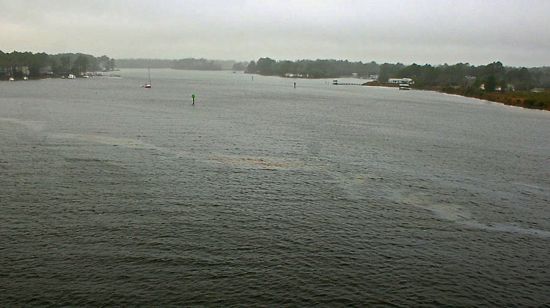 The fuel spill did not stay in Oriental’s harbor. Residents and boaters on Green and Smith Creeks say it was visible — and smellable — the day after the spill. This photo was taken two days after the spill, on Thursday January 17, as the wind shifted sharply and still more fuel — seen here as a sheen on the water — moved from Oriental’s harbor, under the bridge and up Green’s Creek. The creek’s upper reaches are a sensitive nursery for shrimp and other aquatic life.
The fuel spill did not stay in Oriental’s harbor. Residents and boaters on Green and Smith Creeks say it was visible — and smellable — the day after the spill. This photo was taken two days after the spill, on Thursday January 17, as the wind shifted sharply and still more fuel — seen here as a sheen on the water — moved from Oriental’s harbor, under the bridge and up Green’s Creek. The creek’s upper reaches are a sensitive nursery for shrimp and other aquatic life.Whether it’ll be a Letter of Warning or a fine of up to $3,000, Lt. Commander Weaver says any decision on a penalty for Lady Barbara owner Ralph Taylor is months away.
First, he says, the Coast Guard has to put together a “case package” on the January 15 sinking and the aftermath.
Coast Guard: Size Of Spill A FactorAmong the things to be taken in to account for that “case package,” Weaver says, is the size of the spill. “If it makes an emulsion, or a sheen,” he says, “it’s a violation.”
The decks of the Lady Barbara underwater, and a mauve colored fluid circulating on it. The purplish coloration could be seen on white booms which were laid around the hull in an effort to capture some of the spill. They couldn’t contain all of it and pollutants spread across the harbor.After the Lady Barbara’s sinking, the waters on Oriental’s harbor carried both a rainbow-colored sheen and a pink slurry emulsion which sloshed on the surface at the harbor’s northern end, near the Town Dock. Rising from the waters that day was a petroleum-based odor so strong that residents and others in town could smell it blocks away. The smell persisted through most of the daylight hours. It forced some to close their windows altogether.
Did The Owner Take Steps To Reduce The Pollution?The Coast Guard’s Lt. Commander Weaver says his office would also consider how quickly the Lady Barbara’s owner, Ralph Taylor, took “responsibility” for “mitigating the threat of pollution.”
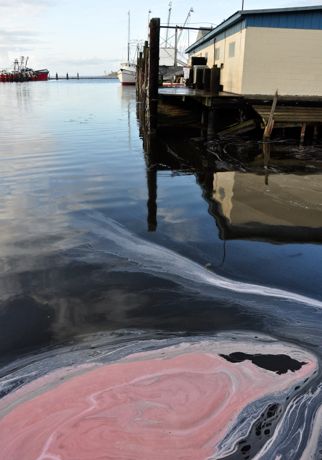 The Coast Guard confirms that the pollutants coming from the Lady Barbara were a mix of diesel fuel, engine lubricant and hydraulic fluid. They coalesced on the waters of Oriental’s harbor. Here was the scene Wednesday January 16 at the Town Dock.
The Coast Guard confirms that the pollutants coming from the Lady Barbara were a mix of diesel fuel, engine lubricant and hydraulic fluid. They coalesced on the waters of Oriental’s harbor. Here was the scene Wednesday January 16 at the Town Dock.The Lady Barbara was noticeably low on her water lines early on the morning of Tuesday January 15. Customers at The Bean coffeehouse across the street from the harbor, were remarking upon it. By that afternoon the 71-foot trawler had sunk at dockside, leaning over to port, her keel resting on the harbor bottom. Water poured in and fluids poured out.
Lady Barbara – when her decks were submerged – two weeks ago. .Sherrill Styron, owner of the Garland Fulcher Seafood Company docks says he called Ralph Taylor as the Lady Barbara showed signs of sinking. Taylor, who lives in Carteret County (where the Lady Barbara is registered, in Marshallberg) did not arrive in Oriental until the next day, Wednesday January 16.
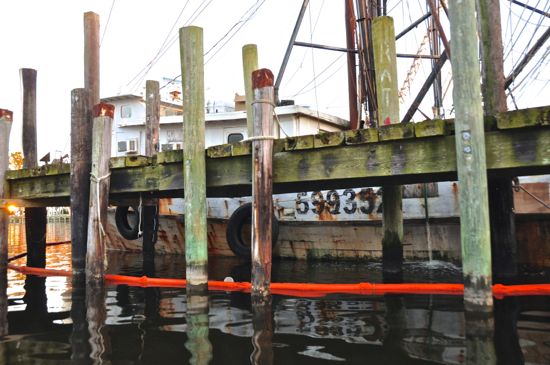 The port side of the Lady Barbara as seen through the docks at Garland Fulcher Seafood once she was floating again. In the water, the orange boom put in place to restrain the oily effluent coming from the trawler. The booms could not contain all of the pollutants.
The port side of the Lady Barbara as seen through the docks at Garland Fulcher Seafood once she was floating again. In the water, the orange boom put in place to restrain the oily effluent coming from the trawler. The booms could not contain all of the pollutants.On Tuesday January 15, while waiting for Ralph Taylor to arrive and deal with his trawler, Styron placed a boom around the sinking Lady Barbara. The boom was deployed to try to contain pollutants and keep them from flowing away from the boat.
Despite that effort, the Lady Barbara’s petroleum-based fluids spread across Oriental’s harbor. They were rainbow iridescent in some places, a strawberry Quik-like mousse in others.
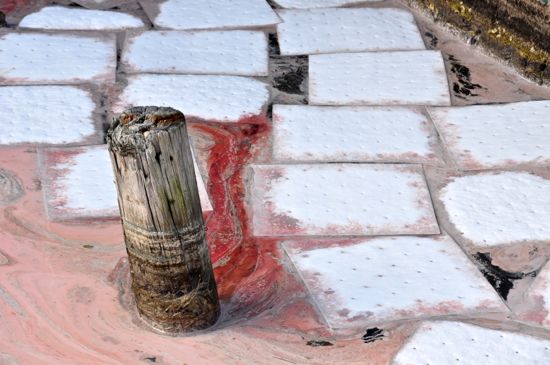 Absorbent pads deployed on to the slurry soaked up some of the pollutants. But as would be seen the next day, a substantial portion of the pollutants were blown out of the harbor by the wind and floated to Greens Creek.Fuel Spill In Green and Smith Creeks As Well As Harbor
Absorbent pads deployed on to the slurry soaked up some of the pollutants. But as would be seen the next day, a substantial portion of the pollutants were blown out of the harbor by the wind and floated to Greens Creek.Fuel Spill In Green and Smith Creeks As Well As HarborSome of the fuel and lubricants were soaked up by absorbent pads laid down in the harbor over the pollutants. But not all of the spill was absorbed.
Rather, it was a sharp change in wind direction on Thursday the 17th — two days after the trawler sank — that appeared to clear Oriental’s harbor of the pollutants.
This may have given some the impression the problem had gone away. It had only gone elsewhere. Some of the fuel sheen could be seen departing Oriental’s anchorage, and floating up Greens Creek on Thursday afternoon. Residents and boaters on Greens and Smith Creeks say they’d already seen and smelled the fuel on their waters a day earlier. Those waters are nursery grounds for shrimp and other aquatic life.
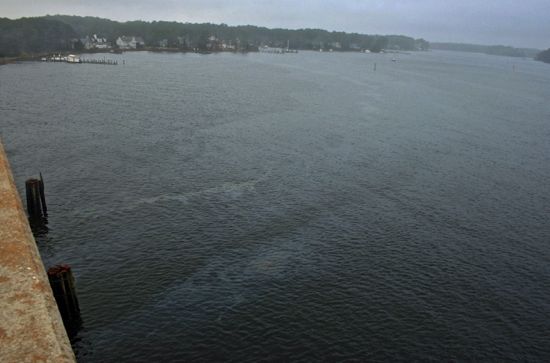 The petroleum-based residue eventually found its way under the bridge. This photo from a TownDock reader, shows the scene Thursday afternoon, January 17.
The petroleum-based residue eventually found its way under the bridge. This photo from a TownDock reader, shows the scene Thursday afternoon, January 17.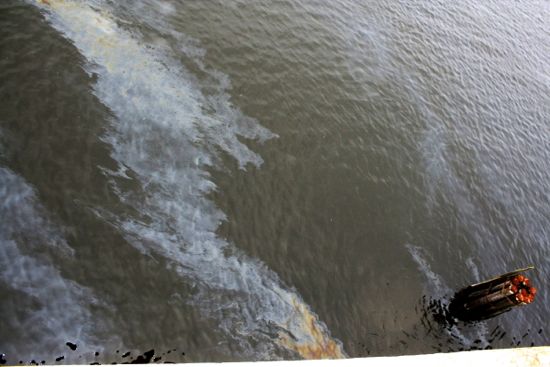 Water .. and more … under the bridge?
Water .. and more … under the bridge?More fuel sheen could be seen again on the harbor water’s surface a week after the sinking. This resurgence came after the trawler’s owner got the Lady Barbara righted and began to pump out the water from inside.
[page]
Lady Barbara’s Owner’s Track Record To Be ConsideredIn determining what penalty – if any – would be lodged against Ralph Taylor because of his boat’s fuel spill, Lt. Commander Weaver says that the Coast Guard would also take in to account whether the Lady Barbara’s owner had any “prior penalties.”
Weaver says that if a boat owner had no previous violations, it was possible that only a Letter of Warning would be sent (and no fine levied.) In the interview with TownDock.net, the Coast Guard official said that he didn’t know Taylor’s past record.
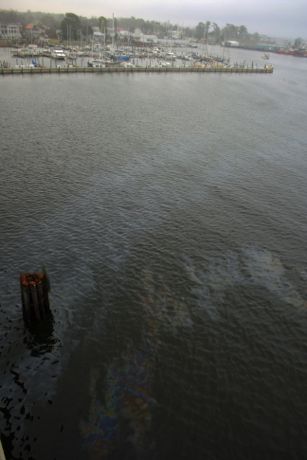 The oily substances that were in the harbor when the Lady Barbara sank seemed to disappear two days later when the wind shifted (from the south to north and east) This is where the wind carried the sheen on the water’s surface: around the corner from the harbor, past the Oriental Harbor Marina and under Oriental bridge toward Green’s Creek.
The oily substances that were in the harbor when the Lady Barbara sank seemed to disappear two days later when the wind shifted (from the south to north and east) This is where the wind carried the sheen on the water’s surface: around the corner from the harbor, past the Oriental Harbor Marina and under Oriental bridge toward Green’s Creek.Lt. Commander Weaver says his Incident Management office in Wilmington which “handles the pollution cases” would send its report to a hearing officer at the Coast Guard’s National Pollution Center. That center processes all the pollution investigations in the country and would recommend what penalty – a Letter of Warning or a fine up to $3,000 – was in order for fouling Oriental’s harbor.
As for whether any agencies with the State of North Carolina could apply penalties of their own in the Lady Barbara case, the Coast Guard’s Lt. Commander Weaver says “they usually look to us to enforce” the law regarding the spilling of fuel.
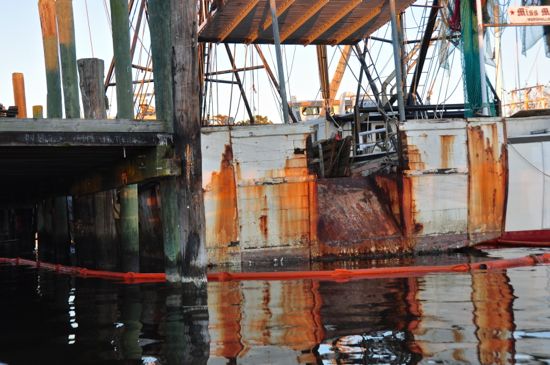 The back end of the Lady Barbara, showing signs of wear.
The back end of the Lady Barbara, showing signs of wear.
